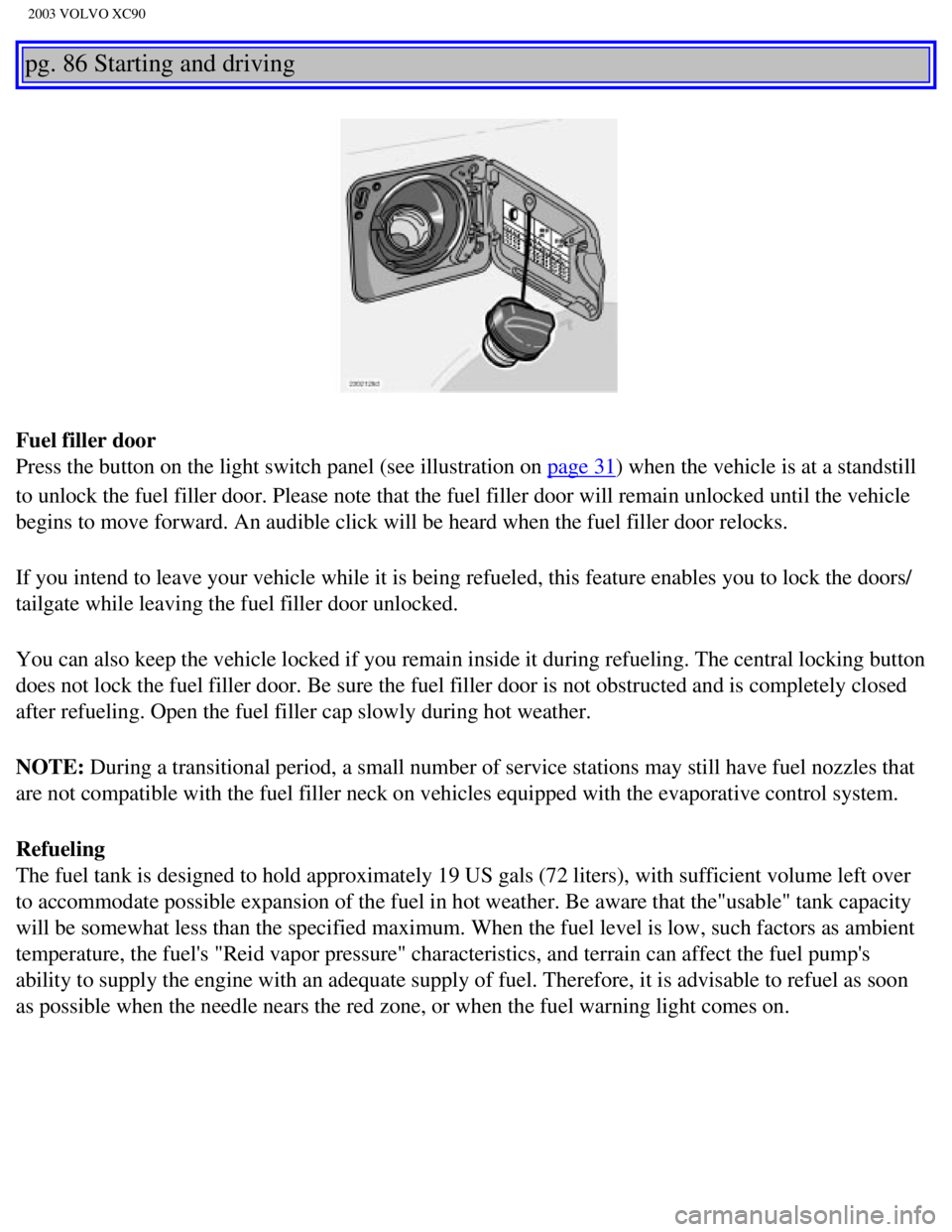Page 107 of 242

2003 VOLVO XC90
pg. 86 Starting and driving
Fuel filler door
Press the button on the light switch panel (see illustration on
page 31) when the vehicle is at a standstill
to unlock the fuel filler door. Please note that the fuel filler door wi\
ll remain unlocked until the vehicle
begins to move forward. An audible click will be heard when the fuel fil\
ler door relocks.
If you intend to leave your vehicle while it is being refueled, this fea\
ture enables you to lock the doors/
tailgate while leaving the fuel filler door unlocked.
You can also keep the vehicle locked if you remain inside it during refu\
eling. The central locking button
does not lock the fuel filler door. Be sure the fuel filler door is not \
obstructed and is completely closed
after refueling. Open the fuel filler cap slowly during hot weather.
NOTE: During a transitional period, a small number of service stations may st\
ill have fuel nozzles that
are not compatible with the fuel filler neck on vehicles equipped with t\
he evaporative control system.
Refueling
The fuel tank is designed to hold approximately 19 US gals (72 liters)\
, with sufficient volume left over
to accommodate possible expansion of the fuel in hot weather. Be aware t\
hat the"usable" tank capacity
will be somewhat less than the specified maximum. When the fuel level is\
low, such factors as ambient
temperature, the fuel's "Reid vapor pressure" characteristics, and terra\
in can affect the fuel pump's
ability to supply the engine with an adequate supply of fuel. Therefore,\
it is advisable to refuel as soon
as possible when the needle nears the red zone, or when the fuel warning\
light comes on.
file:///K|/ownersdocs/2003/2003_XC90/03xc90_06a.htm (4 of 15)12/30/200\
6 4:18:58 PM
Page 133 of 242

2003 VOLVO XC90
Load carrier cover
The vehicle's ignition key or the stud on the edge of the supplied torqu\
e wrench can be used to undo or
tighten the cover. Turn a quarter turn (90 degrees). See illustration.\
pg. 107 Starting and driving
Cold weather precautions
If you wish to check your vehicle before the approach of cold weather, t\
he following advice is worth
noting:
l Make sure that the engine coolant contains 50 percent antifreeze. Any ot\
her mixture will reduce
freeze protection. This gives protection against freezing down to -31°\
F (-35°C). See section "Coolant".
The use of "recycled" antifreeze is not approved by Volvo. Different typ\
es of antifreeze must not
be mixed.
l Volvo recommends using only genuine Volvo antifreeze in your vehicle's r\
adiator. Your Volvo
retailer stocks plenty of Volvo engine coolant to help protect your vehi\
cle during cold weather.
l Try to keep the fuel tank well filled - this prevents the formation of condensation in the tank. \
In
addition, in extremely cold weather conditions it is worthwhile to add f\
uel line de-icer before refueling.
l The viscosity of the engine oil is important. Oil with low viscosity (thinner oil) improves cold-
weather starting as well as decreasing fuel consumption while the engine\
is warming up. For winter use,
5W-30 oil, particularly the synthetic type*, is recommended. Be sure to \
use good quality oil but do not
use cold-weather oil for hard driving or in warm weather. See section "E\
ngine oil" for more information.
l The load placed on the battery is greater during the winter since the windshield wipers, lighting, etc\
.
are used more often. Moreover, the capacity of the battery decreases as \
the temperature drops. In very
cold weather, a poorly charged battery can freeze and be damaged. It is \
therefore advisable to check the
state of charge more frequently and spray an antirust oil on the battery\
posts.
l Volvo recommends the use of snow tires on all four wheels for winter driving - see section "Wheels
and tires."
l To prevent the washer fluid reservoir from freezing, add washer solvents containing antifreeze (see
file:///K|/ownersdocs/2003/2003_XC90/03xc90_06b.htm (15 of 17)12/30/20\
06 4:18:59 PM
Page 195 of 242

2003 VOLVO XC90
2) Vehicles with all wheel drive (AWD), see also page 103
WARNING!
When adding accessories, equipment, luggage and other cargo to your vehi\
cle, the total capacity
weight must not be exceeded.
Capacities
Fuel tank 19 US gals. (72 liters), minimum octane requirement - AKI 87 (RON
91) - unleaded fuel (See also page 84)
Engine oil
B5254T2 6.1 US qts. (5.8 liters)
B6294T 7.1 US qts. (6.7 liters)
Transmission oil
Automatic (AW 55-50 5- speed) 7.9 US qts. (7.5 liters)
Automatic (GM 4-speed) 13.4 US qts (12.7 liters)
Miscellaneous
Power steering 0.9 US qts. (0.9 liters)
Windshield washer reservoir 6.9 US qts. (6.5 liters)
Brake fluid 0.63 US qts. (0.6 liters)
Air conditioning system Front - 2.2 lb. (1 kg), Rear (option) 2.9 lb. (1.3 kg) R 134a
pg. 153 Specifications
Lubricants
Engine oil
Meeting minimum ILSAC specification GF-2, including ACEA A1, API SJ, SJ/\
CF and SJ/ Energy
Conserving.
Oil additives must not be used.
Transmission
Oil grade:
4-speed automatic (on models with 6-cylinder turbo engines):
Dexron III G (Volvo P/N 1161521).
file:///K|/ownersdocs/2003/2003_XC90/03xc90_10.htm (5 of 10)12/30/2006\
4:19:05 PM
Page 232 of 242
2003 VOLVO XC90
Engine oil, capacity 152
Engine specifications
157
Engne oil - checking
130
Environment
iii
F
Fader
165
Federal Clean Air Act
124
FIX NEXT SERVICE
28
Floor mats
62
Fog light
27
Folding sideview mirrors
42
Front seat - backrest
55
Front seats
54
Front seats - heated
35
Front seats - manual adjustment
54
Front seats - power
56
Front suspension
153
Fuel
ii, 84
Fuel filler cap
ii, 86
Fuel filler door
ii, 86
Fuel filler door - unlocking
31
Fuel filler door - unlocking manually
32
Fuel Formulations
85
Fuel gauge
24
Fuel tank, capacity
152
Fuses
145
G
Gasoline
84
Geartronic
91
Geartronic - kickdown
92
Geartronic - manual shifting
92
General information
ii
file:///K|/ownersdocs/2003/2003_XC90/03xc90_12.htm (4 of 14)12/30/2006\
4:19:09 PM